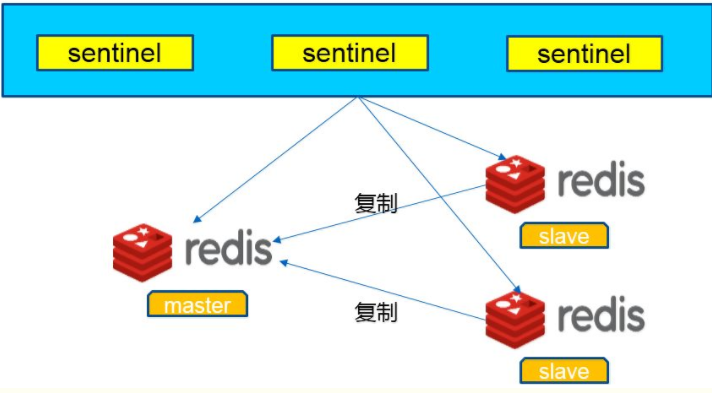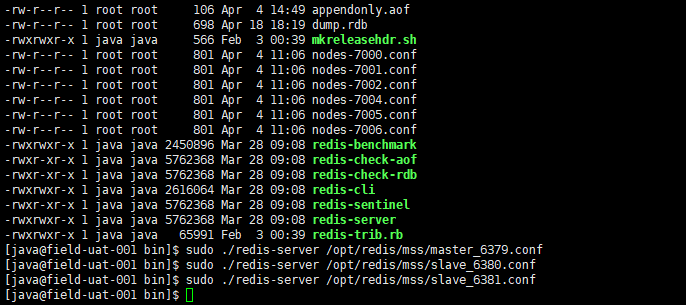新手之:SpringBoot ——Reids主从哨兵整合(CentOS7)
一、Redis主从搭建(一台服务器模拟多个端口)
结构图:)

1.确保安装了Redis,我装在了/opt/redis目录下。可通过"whereis redis-cli"命令查看是否安装。
2.在/opt/redis目录中创建一个文件夹用于存放redis的主从配置文件。"mkdir /opt/redis/mss"

3.我们将复制3个redis配置文件到mss目录下分别代表master_6379.conf(主库)、slave_6380.conf(从库)、slave_6381.conf(从库)
1 sudo cp /opt/redis/etc/redis.conf /opt/redis/mss/master_6379.conf 2 sudo cp /opt/redis/etc/redis.conf /opt/redis/mss/slave_6380.conf 3 sudo cp /opt/redis/etc/redis.conf /opt/redis/mss/slave_6381.conf
4.修改主库配置文件(master_6379.conf):
1 vim /opt/redis/mss/master_6379.conf 2 daemonize yes 3 4 pidfile /var/run/redis_6379.pid 5 6 port 6379 7 8 logfile “/opt/redis/log/master_6379.log” # 该项可不设置,默认输出到/dev/null 9 10 slave-read-only yes # 表示从库只读,如果设置成no,表示从库也是可以写入的
5.修改从库配置文件
slave_6380.conf:
daemonize yes pidfile /var/run/redis_6380.pid port 6380 logfile “/opt/redis/log/slave_6380.log” # 该项可不设置,默认输出到/dev/null slave-read-only yes # 表示从库只读,如果设置成no,表示从库也是可以写入的 slaveof 127.0.0.1 6379 #指向主库服务器IP和端口。(这里的127.0.0.1只是示例,实际中填写自己服务器ip地址,不然项目调用会出问题)
slave_6381.conf:
daemonize yes pidfile /var/run/redis_6381.pid port 6380 logfile “/opt/redis/log/slave_6380.log” # 该项可不设置,默认输出到/dev/null slave-read-only yes # 表示从库只读,如果设置成no,表示从库也是可以写入的 slaveof 127.0.0.1 6379 #指向主库服务器IP和端口。(这里的127.0.0.1只是示例,实际中填写自己服务器ip地址,不然项目调用会出问题)
6.启动reids
启动master和两个slave:用redis-server:启动master_6379.conf,slave_6380.conf,slave_6381.conf

查看启动状态:

从上面看出三个reids服务以及启动成功了。
这里我们就不在做相关测试了,测试可以参考:https://www.2cto.com/database/201704/630874.html
————————————————————————————————分割线———————————————————————————————————————————
二、搭建Redis哨兵模式
在redis目录下创建'sentinel'文件夹方便管理配置文件
sudo mkdir /opt/redis/sentinel
将原有的reids哨兵配置文件拷贝到sentinel目录中。分别命名为:
sudo cp/opt/redis/etc/sentinel.conf/opt/redis/sentinel/sentinel_26379.conf sudo cp /opt/redis/etc/sentinel.conf /opt/redis/sentinel/sentinel_26380.conf sudo cp /opt/redis/etc/sentinel.conf /opt/redis/sentinel/sentinel_26381.conf
修改配置文件:sentinel_26379.conf
sudo vim /opt/redis/sentinel/sentinel_26379.conf
protected-mode no #关闭保护模式 port 26379 #端口 sentinel monitor mymaster [服务器IP] 6379 1 #指向redis主机服务器 sentinel auth-pass mymaster [redis密码] #如果有设置密码需要配置此项
修改配置文件:sentinel_26380.conf
sudo vim /opt/redis/sentinel/sentinel_26380.conf
protected-mode no #关闭保护模式 port 26380 #端口 sentinel monitor mymaster [服务器IP] 6379 1 #指向redis主机服务器 sentinel auth-pass mymaster [redis密码] #如果有设置密码需要配置此项
修改配置文件:sentinel_26381.conf
sudo vim /opt/redis/sentinel/sentinel_26381.conf
protected-mode no #关闭保护模式 port 26381 #端口 sentinel monitor mymaster [服务器IP] 6379 1 #指向redis主机服务器 sentinel auth-pass mymaster [redis密码] #如果有设置密码需要配置此项
启动redis哨兵:首先进入redis bin目录中
cd /opt/redis/bin

我们用redis-sentinel服务来启动哨兵:
sudo ./redis-sentinel /opt/redis/sentinel/sentinel_26379.conf sudo ./redis-sentinel /opt/redis/sentinel/sentinel_26380.conf sudo ./redis-sentinel /opt/redis/sentinel/sentinel_26381.conf
查看启动状态:

详细步骤可以查阅相关资料哦。
————————————————————————————————分割线———————————————————————————————————————————
三、使用Springboot整合redis主从哨兵模式。
pom.xml:
<?xml version="1.0" encoding="UTF-8"?> <project xmlns="http://maven.apache.org/POM/4.0.0" xmlns:xsi="http://www.w3.org/2001/XMLSchema-instance" xsi:schemaLocation="http://maven.apache.org/POM/4.0.0 http://maven.apache.org/xsd/maven-4.0.0.xsd"> <modelVersion>4.0.0</modelVersion> <parent> <groupId>org.springframework.boot</groupId> <artifactId>spring-boot-starter-parent</artifactId> <version>1.5.10.RELEASE</version> <relativePath/> </parent> <properties> <jedis.version>2.9.0</jedis.version> </properties> <dependencies> <dependency> <groupId>org.springframework.boot</groupId> <artifactId>spring-boot-starter-redis</artifactId> <version>1.4.7.RELEASE</version> </dependency> <dependency> <groupId>org.springframework.boot</groupId> <artifactId>spring-boot-starter-data-rest</artifactId> </dependency> <dependency> <groupId>org.springframework.boot</groupId> <artifactId>spring-boot-starter</artifactId> </dependency> </dependencies> <build> <plugins> <plugin> <groupId>org.springframework.boot</groupId> <artifactId>spring-boot-maven-plugin</artifactId> <configuration> <classifier>exec</classifier> </configuration> </plugin> </plugins> </build> </project>
application.yml:
spring:
redis:
database: 0
host: [redis服务器IP地址]
port: 6379
password: [redis密码]
pool:
max-active: 8
max-wait: -1
max-idle: 8
min-idle: 0
timeout: 10000
sentinel:
master: mymaster #主机名称
nodes: 127.0.0.1:26379,127.0.0.1:26380,127.0.0.1:26381 #多哨兵ip地址和端口
springboot RedisConfig配置文件:
package com.eqs.framework.common.util.cache; import org.springframework.beans.factory.annotation.Value; import org.springframework.boot.autoconfigure.EnableAutoConfiguration; import org.springframework.cache.annotation.CachingConfigurerSupport; import org.springframework.cache.annotation.EnableCaching; import org.springframework.context.annotation.Bean; import org.springframework.context.annotation.Configuration; import redis.clients.jedis.JedisPoolConfig; import redis.clients.jedis.JedisSentinelPool; import java.util.Arrays; import java.util.HashSet; import java.util.List; import java.util.Set; /** * @Author: PittZhang */ @Configuration @EnableAutoConfiguration @EnableCaching public class RedisConfig extends CachingConfigurerSupport{ @Value("${spring.redis.host}") private String host; @Value("${spring.redis.port}") private int port; @Value("${spring.redis.timeout}") private int timeout; @Value("${spring.redis.database}") private int database; @Value("${spring.redis.password}") private String password; @Value("${spring.redis.pool.max-idle}") private int maxIdle; @Value("${spring.redis.pool.max-active}") private int maxActive; @Value("${spring.redis.pool.min-idle}") private int minIdle; @Value("${spring.redis.pool.max-wait}") private long maxWaitMillis; @Value("${spring.redis.sentinel.nodes}") private String redisNodes; @Value("${spring.redis.sentinel.master}") private String master; @Bean public JedisPoolConfig jedisPoolConfig(){ JedisPoolConfig jedisPoolConfig = new JedisPoolConfig(); jedisPoolConfig.setMaxIdle(maxIdle); jedisPoolConfig.setMaxWaitMillis(maxWaitMillis); jedisPoolConfig.setMinIdle(minIdle); return jedisPoolConfig; } @Bean public JedisSentinelPool jedisSentinelPool(){ String[] arrNodes = redisNodes.split(","); List<String> listNodes = Arrays.asList(arrNodes); Set sentinels = new HashSet(listNodes); JedisSentinelPool jedisSentinelPool = new JedisSentinelPool(master,sentinels,jedisPoolConfig(),password); return jedisSentinelPool; } }
整合一个通用的redis工具类
RedisCacheClient:
package com.eqs.framework.common.util.cache; import org.apache.commons.lang3.SerializationUtils; import org.springframework.beans.factory.annotation.Autowired; import org.springframework.stereotype.Component; import redis.clients.jedis.Jedis; import redis.clients.jedis.JedisSentinelPool; import java.io.Serializable; import java.util.Set; /** * @Author: PittZhang */ @Component public class RedisCacheClient { @Autowired private JedisSentinelPool jedisPool; /** * 设置key对应的value值 * @param key * @param value */ public void set(String key, Serializable value) { Jedis jedis=null; try{jedis=jedisPool.getResource(); byte[] b= SerializationUtils.serialize(value); // logger.info("redis-cache-client.set key is:"+key+",value is:"+value+", bytes.length:"+b.length); jedis.set(key.getBytes(), b); }finally{ if(jedis != null){ jedis.close(); } } } /** * 设置key对应的value值 * @param key * @param value * @param seconds * 将 key 的值设为 value ,当且仅当 key 不存在。 * 若给定的 key 已经存在,则 SETNX 不做任何动作。 */ public long setnx(String key, Serializable value,Integer seconds) { Jedis jedis=null; try{jedis=jedisPool.getResource(); long i=jedis.setnx(key.getBytes(), SerializationUtils.serialize(value)); if(1==i){ jedis.expire(key.getBytes(), seconds); } return i; }finally{ if(jedis != null){ jedis.close(); } } } public long setnx(String key, Serializable value){ Jedis jedis=null; try{jedis=jedisPool.getResource(); long i=jedis.setnx(key.getBytes(), SerializationUtils.serialize(value)); return i; }finally{ if(jedis != null){ jedis.close(); } } } public String timeGetZero(){ Jedis jedis=null; try{jedis=jedisPool.getResource(); String time = jedis.time().get(0); return time; }finally{ if(jedis != null){ jedis.close(); } } } /** * 设置key对应的value值 * @param key * @param value * @param seconds 过期时间,以秒为单位 */ public void set(String key, Serializable value, Integer seconds) { Jedis jedis = jedisPool.getResource(); try { byte[] b=SerializationUtils.serialize(value); // logger.info("redis-cache-client.set bytes.length:::"+b.length); jedis.set(key.getBytes(), b); if (seconds != null) { jedis.expire(key.getBytes(), seconds); } } finally { if(jedis != null){ jedis.close(); } } } /** * 设置key对应的value值 * @param key * @param value * @param timestamp 过期时间戳 ———— UNIX时间戳 */ public void set(String key, Serializable value, Long timestamp ) { Jedis jedis=null; try{jedis=jedisPool.getResource(); // logger.info("redis-cache-client.set key is:"+key+",value is:"+value); jedis.set(key.getBytes(), SerializationUtils.serialize(value)); if(timestamp != null){ jedis.expireAt(key.getBytes(), timestamp); } }finally{ if(jedis != null){ jedis.close(); } } } /** * 获取key的对应的value * @param key * @return */ public <T>T get(String key) { Jedis jedis=null; try { jedis = jedisPool.getResource(); byte[] v = jedis.get(key.getBytes()); if (v != null && v.length > 0) { // logger.info("redis-cache-client.get,key is:" + key + ", return bytes.length: " + v.length); return SerializationUtils.deserialize(v); } return null; } finally { if (jedis != null) { jedis.close(); } } } /** * 失效 * @param key * @param seconds */ public void expire(String key,Integer seconds){ Jedis jedis=null; try{jedis=jedisPool.getResource(); jedis.expire(key.getBytes(), seconds); }finally{ if(jedis != null){ jedis.close(); } } } /** * 删除key * @param key */ public void delete(String key) { Jedis jedis=null; try{jedis=jedisPool.getResource(); jedis.del(key.getBytes()); }finally{ if(jedis != null){ jedis.close(); } } } /** * 向名称为key的hash中添加元素field * @param key * @param field * @param value */ public void hset(String key,String field,Serializable value){ Jedis jedis=null; try{jedis=jedisPool.getResource(); jedis.hset(key.getBytes(), field.getBytes(), SerializationUtils.serialize(value)); }finally{ if(jedis != null){ jedis.close(); } } } /** * 获取key的hash中field域对应的value * @param key * @param field * @return */ public <T>T hget(String key,String field){ Jedis jedis=null; try{jedis=jedisPool.getResource(); byte[] v=jedis.hget(key.getBytes(), field.getBytes()); return v==null?null:(T)SerializationUtils.deserialize(v); }finally{ if(jedis != null){ jedis.close(); } } } /** * 确认一个key是否存在 * @param key * @return */ public boolean exists(String key) { Jedis jedis=null; try{jedis=jedisPool.getResource(); return jedis.exists(key.getBytes()); }finally{ if(jedis != null){ jedis.close(); } } } /** * key 中储存的数字加上指定的增量值。 * 如果 key 不存在,那么 key 的值会先被初始化为 0 ,然后再执行 INCRBY 命令 * @param key * @param num * @return */ public long incrby(String key,long num){ Jedis jedis=null; try{jedis=jedisPool.getResource(); return jedis.incrBy(key, num); }finally{ if(jedis != null){ jedis.close(); } } } /** * Redis Decrby 命令将 key 所储存的值减去指定的减量值。 * 如果 key 不存在,那么 key 的值会先被初始化为 0 ,然后再执行 DECRBY 操作。 * @param key * @param num * @return */ public long decrby(String key,long num){ Jedis jedis=null; try{jedis=jedisPool.getResource(); return jedis.decrBy(key, num); }finally{ if(jedis != null){ jedis.close(); } } } /** * 在名称为key的list头添加一个值为value的 元素 * @param key * @param value * @return 返回添加后的list的长度 */ public long lpush(String key, Serializable value) { Jedis jedis=null; try{jedis=jedisPool.getResource(); return jedis.lpush(key.getBytes(),SerializationUtils.serialize(value)); }finally{ if(jedis != null){ jedis.close(); } } } /** * 返回并删除名称为key的list中的尾元素 * @param key * @return */ public <T>T rpop(String key){ Jedis jedis=null; try{jedis=jedisPool.getResource(); byte[] v=jedis.rpop(key.getBytes()); return v==null?null:(T)SerializationUtils.deserialize(v); }finally{ if(jedis != null){ jedis.close(); } } } public String getSet(String key,String value){ Jedis jedis=null; try{jedis=jedisPool.getResource(); return jedis.getSet(key, value); }finally{ if(jedis != null){ jedis.close(); } } } public Set<String> keys(String pattern){ Jedis jedis=null; try{jedis=jedisPool.getResource(); return jedis.keys(pattern); }finally{ if(jedis != null){ jedis.close(); } } } }
最后通过注入RedisCacheClient就可以使用了。如果对您有帮助的话,点个推荐吧~



